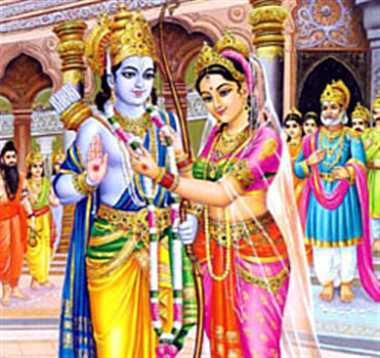Monday, 29 April 2019
Ramayana, Feminist Epic
Editorial by PIYUSH ROY
 Ramayana’s wise women are all but forgotten in our obsession with the male of the species, writes PIYUSH ROY
Ramayana’s wise women are all but forgotten in our obsession with the male of the species, writes PIYUSH ROY
How valuable or in spiring are epico-mythic women — leading lady characters in the Ramayana, like Kaikeyi, Sita, Tara, Surpanakha or Mandodari — as reclaimed icons for contemporary feminism and can their societies and influential male counterparts be termedfeminists-in-retrospect?
The Ramayana unfolds across a robust landscape of credible action led by multiple women characters, beyond its heroine Sita. India’s oldest epic imagines a society where choice — social, marital, political and spiritual — was as much an area of access for a desiring woman, as the man, irrespective of whether she lived in a hermit’s abode or a king’s palace.
Kaikeyi, Sita, Tara and Mandodari stand alongside their powerful husbands; never blind followers, heeding the counsel of their thinking mind always — wrong or right. It is Rama who conducts the Ashvamedha Yajna in the shadow of his abandoned wife’s gold statue to lend the sacrifice sanctity and spectacle.
 Kaikeyi, a warrior queen, as the charioteer of her husband, King Dasharatha, steers and saves him to safety in a ferocious battle between the devas and the asuras. The act gets her the two boons that trigger the events leading to the epic’s first dramatic conflict — Rama’s exile. Rama’s confrontation with Ravana, in the epic’s second major dramatic turn is triggered by another warrior princess Surpanakha’s lustful desiring of a ‘married’ Rama.
Kaikeyi, a warrior queen, as the charioteer of her husband, King Dasharatha, steers and saves him to safety in a ferocious battle between the devas and the asuras. The act gets her the two boons that trigger the events leading to the epic’s first dramatic conflict — Rama’s exile. Rama’s confrontation with Ravana, in the epic’s second major dramatic turn is triggered by another warrior princess Surpanakha’s lustful desiring of a ‘married’ Rama.
The third major catalyst event leading to the eventual finding of Sita and the climactic Rama-Ravana battle, could be possible because the queen of Kishkindha, Tara, had advised her husband Bali to only banish and not kill Sugriva in their duels for the monkey kingdom. Before dying, Bali insists that Sugriva consults Tara on all decisions of statecraft as ‘her advice never goes without effect’. Like a hero’s wife, Tara mourns Bali’s death and refuses the Kishkindha throne when offered to succeed her dead husband. She instead opts for Sugriva’s kingship with her son, Angad, as the heir apparent. Her tact comes to the fore again when Sugriva sends her to pacify a raging Lakshmana, upset over the latter’s forgetting his promise to start searching for Sita.
Mandodari too, never shies from giving sane counsel to the ferocious Ravana, constantly urging him to return Sita with honour. But when the war comes upon their Lankan capital, she doesn’t abandon her husband, as his blood brother Vibhishana did.
The power of the female regent in the times of the Ramayana is further highlighted when for stability and continuity both Sugriva and Vibhishana marry the widows of their dead brothers — Tara and Mandodari respectivey — as an act of statesmanship and assurance of continuity, lending legitimacy to their regency.
Marriages though facilitated by fathers—be it of Sita or her sisters, or Mandodari, the daughter of asura-king Maya — the daughters’ willingness is always sought, even if the proposals were about the most desirable grooms in the land. The Ramayana’s women — whether driven by love, lust or high- purpose — never shy from articulating choice and are rarely restrained by their male counterparts. Rama indulges Sita’s ‘silly’ wish for the golden deer while being aware of it being a trap. Of the three males who try coveting women against their will, while Ravana and Bali get killed, Indra is cursed for defiling Ahalya.
Though the Ramayana effects categorical punishment against any violation of woman, none of the women, from queen Kaikeyi to ascetic Anasuya, show any incapability for self-defence or the need for male protection ever. Sita is acknowledged in Valmiki’sRamayana for her ability to ‘reduce Ravana to ashes through the fire of her chastity’ alone. She, however, resists the power to not deprive ‘Rama’s arrow from its legitimate glory’. Other Ramayanas have portrayed her from being a warrior princess of tremendous strength, for example, playfully lifting Shiva’s heavy bow in her childhood, to being the slayer of the thousand-headed Sahastra Ravana in the Adbhuta Ramayana.
Equal opportunities and a warrior’s disposition are evidenced, to arguably greater degree among men and women in the asura community, where women soldiers are neither a rarity, nor a surprise. The gatekeeper of Ravana’s golden city at its sea frontier is a woman called Lankini; the caretaker of his most precious possession, Sita in the Ashok- Van, is the brave and compassionate, Trijata; while Ravana’s grandmother, demoness Tadaka, lorded over forests bordering his empire and Ayodhya.
Beyond the epic’s politico-royal land- scape, its spiritual scape of forests and ashramas too features strong-willed women in the ‘ascetic-like’ Anasuya, Shabari and Swayamprabha. The latter two women lead single, independent and fulfilling lives by choice. Shabari shows how salvation can come to the sincere, irrespective of ancestry, scholarship, sex or rituals. Swayamprabha despite living in the midst of plenty as the guard of a beautiful grove constructed by Maya, leads a life of self-abnegation, extending hospitality to many weary beings, including Hanuman in distress. The wizened old Anasuya is introduced to be of equal ascetic merit as her renowned sage-husband, Atri. She gets the river Ganga to flow through their ashram in times of drought through the power of her asceticism. In the rigours of their tapas, penance, these women challenge and overcome the other men- only ability towards cultivating an aptitude and attraction for austerity—as a motivated, practiced life choice.
Even in her demure heroine characterisations, oscillating between the lives of a lavish royal and an austere forester, Sita makes her life choices always, except once when she is abandoned in pregnancy by royal decree. She decides to join Rama in exile; she urges him to go after the golden deer; she opts for the Agni Pariksha, trial by fire, and she decides never to return to Ayodhya for a second test of purity. Her anger is like the simmering rage of the prakriti, nature. Her upbringing enables her immense restraint but when it tips over, the earthquakes beneath and splits, literally.
With the freedom to own actions and choose the words in one’s speech, come the consequences of personal err as well. Sita pays dearly for her cruel thrust against Lakshmana’s pious intentions to protect her in Rama’s absence, by wrongfully chiding him for coveting her. First, she is captured by Ravana and then is the subject of a scandal spread by the citizens of Ayodhya, post her ascendancy as the regent queen.
Modern feminists may tend to review Sita as a ‘compromising’ or ‘suffering’ heroine, but on parameters of choice, equality and opportunity; she or her gender are rarely disadvantaged by their context. Unlike their counterparts from subsequent epico-literary creations from the Indic region or other cultures and civilisations, the Ramayana’s women characters, while covering the entire spectrum of female needs, roles, aspirations and identities — be it as single, in- dependent or married individuals; home- bound or of-the-world; intensely private or power craving; exploring desire or encountering austerity — get rarely judged or denied, if their wants are not unfair or conflicting with the fundamental rights of another.
Most importantly, they match prowess in callings that in later times came to be seen as exclusive men-only skills or life choices — such as physical combat and austerity.
Hence, seeking feminists in the times of the Ramayana is an arguably untenable quest because the essential drivers of the feminism movement — equality of rights and equality in opportunities — were choices available, exercised and enjoyed by each of its women characters. This ‘right to equality and opportunity, ‘a naturally accorded choice to men and women in the epic, is perhaps the essence edge that made their ‘age’ a yuga of Satya or Truth.
INDIA’S OLDEST EPIC, THE RAMAYANA, IMAGINES A SOCIETY WHERE CHOICE — SOCIAL, MARITAL, POLITICAL AND SPIRITUAL — WAS AS MUCH AN AREA OF ACCESS FOR A DESIRING WOMAN, AS THE MAN
Quote from the True Charm and Power of Vedanta
What being truly spiritual means
Now, what does it take to be spiritual?
In an absolute sense, spirituality denotes the illumined state of existence which one can have only after seeing God or realizing one’s identity with the Supreme Spirit.
In a relative sense, to live a life of that kind of discipline which ultimately leads to the realization of God or experience of Atman, and thus brings about the liberation of the spirit, is also being spiritual.
In this way of living one has to find one’s way to recognize a divine principle-whatever name one may give to it which interprets, interpenetrates and undergirds the phenomenal world of which man is a part. When one continues to think act and grow with a progressive sense of relationship . with that principle one becomes more and more spiritual .
It has been said that the business of science is to deal with “facts”. But what is a “fact”? that which exists or occurs may be defined as a fact. But how do we know what exists?
Through our senses of perception directed by our mind we know what exists. Can there be no such case in which our senses or perception fail to apprehended something that exists? Thee can be such a case. For the blind man the tree in front of him does not exist. But irrespective of his not knowing it, the tree exists. Thus we do not deal with facts as such even in science, but only with our awareness of what seems to exist to man’s dealings with facts, warmness is inseparable from the fact. Now this inseparable awareness is itself the great fact of life. Religion, in its finest reaches deals with the fact. At one pole of existence is the awareness of fact, at another is the fact of awareness. The former is the subject matter of science; and the latter of religion. Courtesy can one be scientific and yet spiritual?
But, if He exists?
I drive joy There was a doctor in Benaras who spent 7 minutes in the morning and evening for mediation on God. Knowing this, his colleagues and friends laughed at him. One day they argued that he was wasting ten precious minutes on something, which he had been misled into believing. The doctor replied, “Well, if God does not exist, I agree that I am wasting ten minutes a day. But, if He exists? I am afraid you are wasting your entire lifetime. I prefer to waste ten minutes rather than a lifetime. Why should you grudge me the 10 minutes joy that I derive 4m.
ILLUSTRATED REVIEW : 7th Heaven moment of the week in Ipl Rajasthan royal won by 7 and v.arron no 77 won man of the matches.










